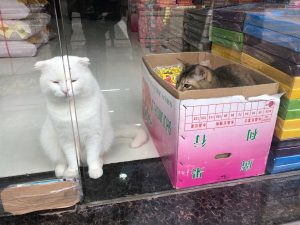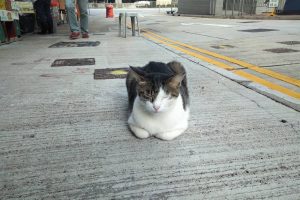A Reflection on Cats, Community and a little more
By Wan Lok Yee Luisa

In particularly stressful times, just encountering a shop cat in the neighbourhood is enough to make my day. For many, spotting shop cats, or snapping a picture of them doing something silly, has become a way to keep spirits up in Hong Kong these days. In the myriad of Facebook community groups that sprung up in recent years, the topic of neighbourhood cats is one that comes up often. A white cat named Siu Bo, for instance, became so famous in my community chatgroup that he was featured by an online content farm. While the original purpose of shop cats may have been rodent control, these felines have become a way for people to connect with one another, especially in the quieter parts of Hong Kong that still manage to keep high-rises and shopping malls away.
The habit of keeping shop cats, or what people in other parts of the world call “bodega cats”, is associated with less affluent or less modern areas in the city. In my neighbourhood, cats are spotted at fruit stalls, Chinese medicine clinics, and old-timey grocery stores that stock whatever that supermarket chains don’t carry. Even though the area I live in is considered old and shabby by some, it is also where you can find what people nostalgically refer to as “old Hong Kong”. In some of the shops where cats roam, you will find staff who refuse to switch to digital scales, or shopkeepers who still insist on delivering sacks of rice to nearby restaurants on foot. For me, one of the perks of purchasing from these stores is the opportunity to play with the cats and chat with the shopkeepers and regulars about the cats’ habits and quirks. In a neighbourhood with a significant ageing population, these small things have always been a way of life. However, as the city itself is becoming more and more unrecognisable to me, the little things that make up my community are also disappearing before my eyes.

Anticipating an increase in sales because of the opening of a new MTR station, landlords have increased the rent in my neighbourhood. Even in a district as quiet as mine, the MTR Corporation has marketed it as a tourist attraction, which dumbfounded most who live here. Bar the initial wave of curious visitors who came solely because of the new station, my district is not exactly the flashy place that corporates or property agents make it out to be. Yet, the damage is done. Some older businesses are shut down for redevelopment, and stylish cafes are opened in their place. The papier-mâché shop where Siu Bo the cat lived (the ones that sell traditional funerary offerings and occasionally some stationery), for instance, had to move to a different district because the landlord threatened to increase the rent by at least 30%. Because of this, the shopkeepers had to give away Siu Bo’s sister, Fafa, to a different family because their new location is significantly smaller. While stories like these are not unfamiliar to a city that has undergone tremendous change in just a few decades, one begins to wonder whether every bit of it must be made anew.
For one, I would hate to see shop cats, and everything associated with them, go. Most malls have rules about keeping animals in stores, and the new shops that blossomed around town don’t exactly cater to the demographic of my district. Of course, the new MTR station did make my life easier, but I also managed without it for the past 20 years. Personally, I’d rather plan my time a little better than not be able to see the cats that run my neighbourhood. How would I walk home without swerving to avoid a cat idly lounging in the middle of the street? What would I do if there were no more cats to judge my purchases? Perhaps I’d find out the answer to these questions sooner than I’d like.
